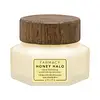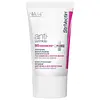What's inside
What's inside
 Key Ingredients
Key Ingredients

 Benefits
Benefits

 Concerns
Concerns

 Ingredients Side-by-side
Ingredients Side-by-side

Water
Skin ConditioningGlycerin
HumectantButyrospermum Parkii Butter
Skin ConditioningCaprylic/Capric Triglyceride
MaskingC13-15 Alkane
SolventCetearyl Alcohol
EmollientPentaerythrityl Tetraisostearate
Emollient1,2-Hexanediol
Skin ConditioningBis-Diglyceryl Polyacyladipate-1
EmollientDiisostearyl Malate
EmollientXylitylglucoside
HumectantHoney Extract
HumectantBetaine
HumectantPanthenol
Skin ConditioningHydrogenated Rapeseed Oil
EmollientHelianthus Annuus Seed Oil Unsaponifiables
EmollientCeramide NP
Skin ConditioningPropolis Extract
Skin ConditioningRoyal Jelly Extract
Skin ConditioningTocopherol
AntioxidantFicus Carica Fruit Extract
HumectantHippophae Rhamnoides Oil
EmollientGlucose
HumectantBisabolol
MaskingXylitol
HumectantAnhydroxylitol
HumectantCetearyl Glucoside
EmulsifyingTriolein
Skin ConditioningAcrylates/C10-30 Alkyl Acrylate Crosspolymer
Emulsion StabilisingHydroxyethyl Acrylate/Sodium Acryloyldimethyl Taurate Copolymer
Emulsion StabilisingArginine
MaskingAroma
Hydroxyacetophenone
AntioxidantXanthan Gum
EmulsifyingGlyceryl Dioleate
EmollientSodium Dilauramidoglutamide Lysine
HumectantSodium Phytate
Sorbitan Isostearate
EmulsifyingCitric Acid
BufferingPotassium Sorbate
PreservativeSodium Benzoate
MaskingWater, Glycerin, Butyrospermum Parkii Butter, Caprylic/Capric Triglyceride, C13-15 Alkane, Cetearyl Alcohol, Pentaerythrityl Tetraisostearate, 1,2-Hexanediol, Bis-Diglyceryl Polyacyladipate-1, Diisostearyl Malate, Xylitylglucoside, Honey Extract, Betaine, Panthenol, Hydrogenated Rapeseed Oil, Helianthus Annuus Seed Oil Unsaponifiables, Ceramide NP, Propolis Extract, Royal Jelly Extract, Tocopherol, Ficus Carica Fruit Extract, Hippophae Rhamnoides Oil, Glucose, Bisabolol, Xylitol, Anhydroxylitol, Cetearyl Glucoside, Triolein, Acrylates/C10-30 Alkyl Acrylate Crosspolymer, Hydroxyethyl Acrylate/Sodium Acryloyldimethyl Taurate Copolymer, Arginine, Aroma, Hydroxyacetophenone, Xanthan Gum, Glyceryl Dioleate, Sodium Dilauramidoglutamide Lysine, Sodium Phytate, Sorbitan Isostearate, Citric Acid, Potassium Sorbate, Sodium Benzoate
Water
Skin ConditioningGlycerin
HumectantPentaerythrityl Tetraisostearate
EmollientTrimethylolpropane Tricaprylate/Tricaprate
EmollientNeopentyl Glycol Diheptanoate
EmollientPropanediol
SolventMyristyl Nicotinate
Skin ConditioningCetearyl Alcohol
EmollientButylene Glycol
HumectantBis-Stearyl Dimethicone
EmollientGlyceryl Stearate
EmollientTheobroma Grandiflorum Seed Butter
Skin ConditioningDimethicone
EmollientSorbitan Stearate
EmulsifyingStearoxymethicone/Dimethicone Copolymer
Emollient1,2-Hexanediol
Skin ConditioningPalmitoyl Tripeptide-38
Skin ConditioningOryza Sativa Bran Extract
Skin ConditioningPalmitoyl Tetrapeptide-7
Skin ConditioningAstrocaryum Murumuru Seed Butter
EmollientPalmitoyl Tripeptide-1
Skin ConditioningCopper Tripeptide-1
Skin ConditioningSaccharide Isomerate
HumectantPanthenol
Skin ConditioningHydroxyethyl Acrylate/Sodium Acryloyldimethyl Taurate Copolymer
Emulsion StabilisingPEG-40 Stearate
EmulsifyingAstrocaryum Vulgare Kernel Oil
Skin ConditioningPolysilicone-11
Butyrospermum Parkii Butter
Skin ConditioningCeteareth-20
CleansingBisabolol
MaskingCaprylhydroxamic Acid
Nicotiana Benthamiana Hexapeptide-40 Sh-Oligopeptide-1
Skin ConditioningPhaseolus Lunatus Seed Extract
EmollientAloe Barbadensis Leaf Juice
Skin ConditioningBacillus/Sea Salt Ferment Filtrate
Skin ConditioningZingiber Officinale Root Extract
MaskingRosmarinus Officinalis Leaf Extract
AntimicrobialPolyglyceryl-4 Diisostearate/Polyhydroxystearate/Sebacate
EmulsifyingPentaclethra Macroloba Seed Oil/Behenic Acid/Aminopropanediol Amides/Esters
EmollientHelianthus Annuus Extract
EmollientHydrolyzed Hyaluronic Acid
HumectantEvodia Rutaecarpa Fruit Extract
Skin ConditioningSodium Hyaluronate Crosspolymer
HumectantNymphaea Alba Flower Extract
Skin ConditioningMethylglucoside Phosphate
Skin ConditioningCetyl Hydroxyethylcellulose
Emulsion StabilisingAdenosine
Skin ConditioningIsohexadecane
EmollientSorbitan Isostearate
EmulsifyingHydroxypropyl Cyclodextrin
MaskingCopper Lysinate/Prolinate
Skin ConditioningAminomethyl Propanol
BufferingDicaprylyl Ether
EmollientDipotassium Phosphate
BufferingEthylhexyl Stearate
EmollientSodium Isostearate
CleansingPolysorbate 60
EmulsifyingResveratrol
AntioxidantXanthan Gum
EmulsifyingDisodium EDTA
Parfum
MaskingLactic Acid
BufferingMica
Cosmetic ColorantRutin
AntioxidantTocopherol
AntioxidantSodium Citrate
BufferingCitric Acid
BufferingCI 77891
Cosmetic ColorantCI 77491
Cosmetic ColorantWater, Glycerin, Pentaerythrityl Tetraisostearate, Trimethylolpropane Tricaprylate/Tricaprate, Neopentyl Glycol Diheptanoate, Propanediol, Myristyl Nicotinate, Cetearyl Alcohol, Butylene Glycol, Bis-Stearyl Dimethicone, Glyceryl Stearate, Theobroma Grandiflorum Seed Butter, Dimethicone, Sorbitan Stearate, Stearoxymethicone/Dimethicone Copolymer, 1,2-Hexanediol, Palmitoyl Tripeptide-38, Oryza Sativa Bran Extract, Palmitoyl Tetrapeptide-7, Astrocaryum Murumuru Seed Butter, Palmitoyl Tripeptide-1, Copper Tripeptide-1, Saccharide Isomerate, Panthenol, Hydroxyethyl Acrylate/Sodium Acryloyldimethyl Taurate Copolymer, PEG-40 Stearate, Astrocaryum Vulgare Kernel Oil, Polysilicone-11, Butyrospermum Parkii Butter, Ceteareth-20, Bisabolol, Caprylhydroxamic Acid, Nicotiana Benthamiana Hexapeptide-40 Sh-Oligopeptide-1, Phaseolus Lunatus Seed Extract, Aloe Barbadensis Leaf Juice, Bacillus/Sea Salt Ferment Filtrate, Zingiber Officinale Root Extract, Rosmarinus Officinalis Leaf Extract, Polyglyceryl-4 Diisostearate/Polyhydroxystearate/Sebacate, Pentaclethra Macroloba Seed Oil/Behenic Acid/Aminopropanediol Amides/Esters, Helianthus Annuus Extract, Hydrolyzed Hyaluronic Acid, Evodia Rutaecarpa Fruit Extract, Sodium Hyaluronate Crosspolymer, Nymphaea Alba Flower Extract, Methylglucoside Phosphate, Cetyl Hydroxyethylcellulose, Adenosine, Isohexadecane, Sorbitan Isostearate, Hydroxypropyl Cyclodextrin, Copper Lysinate/Prolinate, Aminomethyl Propanol, Dicaprylyl Ether, Dipotassium Phosphate, Ethylhexyl Stearate, Sodium Isostearate, Polysorbate 60, Resveratrol, Xanthan Gum, Disodium EDTA, Parfum, Lactic Acid, Mica, Rutin, Tocopherol, Sodium Citrate, Citric Acid, CI 77891, CI 77491
 Reviews
Reviews

Ingredients Explained
These ingredients are found in both products.
Ingredients higher up in an ingredient list are typically present in a larger amount.
1,2-Hexanediol is a synthetic liquid and another multi-functional powerhouse.
It is a:
- Humectant, drawing moisture into the skin
- Emollient, helping to soften skin
- Solvent, dispersing and stabilizing formulas
- Preservative booster, enhancing the antimicrobial activity of other preservatives
Bisabolol is famous for its skin soothing properties. It does this by blocking inflammatory signals, helping to reduce your body's reaction to irritation.
This ingredient also interferes with the process of hyperpigmentation. This can help with reducing dark spots and uneven tone.
Bisabolol is an antioxidant. Antioxidants help fight free-radicals. Free-radicals are molecules that may damage your skin cells. By fighting these free-radicals, Bisabolol may slow down signs of aging.
Studies have shown Bisabolol to have antimicrobial properties and may be a fungicide. These properties help preserve a product's shelf life.
All these properties makes bisabolol a great skin barrier helper ingredient.
Bisabolol also helps the absorption of other ingredients.
Note: Synthetic Bisabolol has been shown to be less effective.
Learn more about BisabololThis ingredient is also known as shea butter. It is an effective skin hydrator and emollient.
Emollients help soothe and soften your skin. It does this by creating a protective film on your skin. This barrier helps trap moisture and keeps your skin hydrated. Emollients may be effective at treating dry or itchy skin.
Shea butter is rich in antioxidants. Antioxidants help fight free-radicals, or molecules that may harm the body. It is also full of fatty acids including stearic acid and linoleic acid. These acids help replenish the skin and keep skin moisturized.
While Shea Butter has an SPF rating of about 3-4, it is not a sunscreen replacement.
Shea butter may not be fungal acne safe. We recommend speaking with a professional if you have any concerns.
Learn more about Butyrospermum Parkii ButterCetearyl alcohol is a mixture of two fatty alcohols: cetyl alcohol and stearyl alcohol. It is mainly used as an emulsifier. Emulsifiers help prevent the separation of oils and products. Due to its composition, it can also be used to thicken a product or help create foam.
Cetearyl alcohol is an emollient. Emollients help soothe and hydrate the skin by trapping moisture.
Studies show Cetearyl alcohol is non-toxic and non-irritating. The FDA allows products labeled "alcohol-free" to have fatty alcohols.
This ingredient is usually derived from plant oils such as palm, vegetable, or coconut oils. There is debate on whether this ingredient will cause acne.
Due to the fatty acid base, this ingredient may not be Malassezia folliculitis safe.
Learn more about Cetearyl AlcoholCitric Acid is an alpha hydroxy acid (AHA) naturally found in citrus fruits like oranges, lemons, and limes.
Like other AHAs, citric acid can exfoliate skin by breaking down the bonds that hold dead skin cells together. This helps reveal smoother and brighter skin underneath.
However, this exfoliating effect only happens at high concentrations (20%) which can be hard to find in cosmetic products.
Due to this, citric acid is usually included in small amounts as a pH adjuster. This helps keep products slightly more acidic and compatible with skin's natural pH.
In skincare formulas, citric acid can:
While it can provide some skin benefits, research shows lactic acid and glycolic acid are generally more effective and less irritating exfoliants.
Most citric acid used in skincare today is made by fermenting sugars (usually from molasses). This synthetic version is identical to the natural citrus form but easier to stabilize and use in formulations.
Read more about some other popular AHA's here:
Learn more about Citric AcidGlycerin is already naturally found in your skin. It helps moisturize and protect your skin.
A study from 2016 found glycerin to be more effective as a humectant than AHAs and hyaluronic acid.
As a humectant, it helps the skin stay hydrated by pulling moisture to your skin. The low molecular weight of glycerin allows it to pull moisture into the deeper layers of your skin.
Hydrated skin improves your skin barrier; Your skin barrier helps protect against irritants and bacteria.
Glycerin has also been found to have antimicrobial and antiviral properties. Due to these properties, glycerin is often used in wound and burn treatments.
In cosmetics, glycerin is usually derived from plants such as soybean or palm. However, it can also be sourced from animals, such as tallow or animal fat.
This ingredient is organic, colorless, odorless, and non-toxic.
Glycerin is the name for this ingredient in American English. British English uses Glycerol/Glycerine.
Learn more about GlycerinThis is a synthetic polymer. It helps improve the texture of products by adding thickness and gel-like feel.
It is also an emulsifer, meaning it prevents ingredients such as oil and water from separating. It also helps evenly disperse other ingredients.
Panthenol is a common ingredient that helps hydrate and soothe the skin. It is found naturally in our skin and hair.
There are two forms of panthenol: D and L.
D-panthenol is also known as dexpanthenol. Most cosmetics use dexpanthenol or a mixture of D and L-panthenol.
Panthenol is famous due to its ability to go deeper into the skin's layers. Using this ingredient has numerous pros (and no cons):
Like hyaluronic acid, panthenol is a humectant. Humectants are able to bind and hold large amounts of water to keep skin hydrated.
This ingredient works well for wound healing. It works by increasing tissue in the wound and helps close open wounds.
Once oxidized, panthenol converts to pantothenic acid. Panthothenic acid is found in all living cells.
This ingredient is also referred to as pro-vitamin B5.
Learn more about PanthenolPentaerythrityl Tetraisostearate is derived from isostearic acid. It is an emollient and emulsifier.
The highest concentration of this ingredient is found in lipsticks.
This ingredient is minimally water soluble and may not be Malassezia folliculitis, or fungal-acne safe.
Learn more about Pentaerythrityl TetraisostearateSorbitan Isostearate is an emulsifer and cleaning agent. It is created from isostearic acid and sorbitol.
As an emulsifier, Sorbitan Isostearate prevents oils and water from separating.
Due to its isostearic acid base, it may not be safe for Malassezia or fungal acne.
Learn more about Sorbitan IsostearateTocopherol (also known as Vitamin E) is a common antioxidant used to help protect the skin from free-radicals and strengthen the skin barrier. It's also fat soluble - this means our skin is great at absorbing it.
Vitamin E also helps keep your natural skin lipids healthy. Your lipid skin barrier naturally consists of lipids, ceramides, and fatty acids. Vitamin E offers extra protection for your skin’s lipid barrier, keeping your skin healthy and nourished.
Another benefit is a bit of UV protection. Vitamin E helps reduce the damage caused by UVB rays. (It should not replace your sunscreen). Combining it with Vitamin C can decrease sunburned cells and hyperpigmentation after UV exposure.
You might have noticed Vitamin E + C often paired together. This is because it is great at stabilizing Vitamin C. Using the two together helps increase the effectiveness of both ingredients.
There are often claims that Vitamin E can reduce/prevent scarring, but these claims haven't been confirmed by scientific research.
Learn more about TocopherolWater. It's the most common cosmetic ingredient of all. You'll usually see it at the top of ingredient lists, meaning that it makes up the largest part of the product.
So why is it so popular? Water most often acts as a solvent - this means that it helps dissolve other ingredients into the formulation.
You'll also recognize water as that liquid we all need to stay alive. If you see this, drink a glass of water. Stay hydrated!
Learn more about WaterXanthan gum is used as a stabilizer and thickener within cosmetic products. It helps give products a sticky, thick feeling - preventing them from being too runny.
On the technical side of things, xanthan gum is a polysaccharide - a combination consisting of multiple sugar molecules bonded together.
Xanthan gum is a pretty common and great ingredient. It is a natural, non-toxic, non-irritating ingredient that is also commonly used in food products.
Learn more about Xanthan Gum